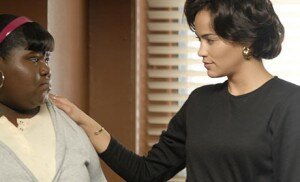Something precious is missing
A “Precious” Reaction Teaser – This Friday a Race-Talk Special Edition
***SPOILER ALERT***
Living outside of a major metropolitan area can put a damper on being a moviegoer, but I finally saw Precious. From all the reviews, I had a hunch the essence of the book would be lost in translation. In many ways, the film captures the basic elements of interpersonal abuse and perseverance.

Courtesy of Lionsgate
What is missing from the film is the bigger picture.
The institutional dynamics of mistreatment, what stood out most to me in the novel, were essentially missing from the film. Focusing solely on interpersonal transgressions allows us to be saddened and outraged while distancing ourselves from the abuse Precious experienced. It happened to her. Other people were the perpetrators. Had the institutional, systemic examples of oppression been included in the movie, we would have been pushed to go beyond what Precious’ parents did to her and would have been made more aware of how our very own systems played a role in failing her. Push revealed, through the lens of Precious and her classmates, how institutions were failing young people in 1980s Harlem. Perhaps some of that depth was lost through the singular focus on Precious in the film version, whereas the novel allowed us to get to know the intricate stories of the classmates.
The most compelling example of this omission of institutional dynamics is that in the novel, Precious tells the nurses who tend to her- after the birth of her first child at the age of 12- that her own father was also the father of her baby. In that instant, Precious’ life should have changed. I am not naïve enough to say that it would have been all roses, but someone should have intervened. The same tragedy occurred after the birth of Precious’ second child. She reported, at the age of 16, that her father was the father of her baby. To the best of my knowledge, registered nurses are mandated reporters required to report abuse of a minor. Furthermore, the novel describes how Precious’ seeks help from the hospital when she returns after being discharged that day.
The fight with her mother leads her back, but she is met with neglect and told to go to a shelter. A minor, still bleeding from delivery, and her several-day-old baby are directed towards a shelter in the dead of winter. I am not suggesting that any of these individuals has something against Precious’ personally. I am also not suggesting that these institutions- the hospital or social services- should have poured all of their resources into this one situation. But I can’t help but think that something more could have been done. Why do we have these institutions if not to serve us in some way? More specifically, if not to serve the least of us- children?

Courtesy of Lionsgate
The film not only omits some of these key pieces of information, but it also distorts them to suggest that Precious does not want help. When talking to her principal before being suspended from school, the film dialogue includes an inquiry about what is going on in the home after which Precious becomes belligerent. No such inquiry exists in the book. While the principal suggested she might visit the home to talk to Precious’ mother (as she also does in the film) that is far from a genuine interest in trying to understand how home life contributed to Precious’ second pregnancy and below grade level academic performance. In the novel, this example was not the first time that the education system failed Precious.
A child who is seven and sits in the back of the classroom all day- literally- and urinates on herself would be a red flag for an intervention of some kind, right? A parent teacher conference, a referral to a social worker, and possibly a subsequent Independent Education Plan might be in order. However when this example occurred in the novel, and Precious’ mother did not respond to the school, the principal concluded that the teacher should focus on students who want to learn. What does it say about our supposed equalizer called the public education system when a child who is clearly troubled is neglected so blatantly? I understand that then and now schools, disproportionately those who serve black and brown children, are under-resourced and lack funding. However, those responses in and of themselves are excuses for these institutional failings. They do not explain away what happened to Precious, they actually strengthen the argument that children are being left behind and the institution of education is not doing enough to meet their needs.
Some might argue that it is not the schools place to fix what is broken in the home. I am not suggesting that the schools re-parent. However, I am suggesting that perhaps the education system working in collaboration with social services could have intervened in a situation like Precious’ to allow her more of an opportunity to learn and thrive. Call me a dreamer. That’s what I thought civilized societies attempted to do- set up institutions to foster individual growth for the larger betterment and common good. At least that is what we have implicitly and explicitly attempted to do through the existence of entities such as the foster care system, mandated reporting or national programs like Big Brothers Big Sisters.
The film saddened me not only because it highlights the atrocities of abuse but also because it shines a light on how little we valued Precious’ life. I say “we,” because people make up institutions. There was something about the systems that Precious came in contact with that did not see or value her enough to truly serve her. To my knowledge, we cannot choose our parents. It is our hope that parents foster growth in their children in a positive way, but we cannot mandate such behavior. However, we do have control over the institutions in our society- their aims, scopes and resources. We are the engines that keep institutions thriving and set their course. It’s convenient for us to acknowledge institutional failings when they cause tragedies such as the Clemmons’ police shooting and Huckabee’s commutation of his sentence. However, it would behoove us to be aware of institutional dynamics in proactive rather than reactive ways.

Courtesy of Lionsgate
Precious was abused by her parents and abused by her society. I like the analogy used by Crossroads that institutional racism is the systems that kick the butts of people of color. Precious was struck down by the systems of education, social service, and the media. The systemic media oppression came in the form of colorism and the reification of Western ideals of beauty. Precious’ parents’ transgressions were personal, but the others were systemic. Taking care to understand the distinctions between various levels of oppression can help focus energy to combat such transgressions.
We Americans love a rugged-individual-triumphs-over-adversity story. I understand why this aspect of the novel shone through. My hunch is that had the institutional dynamics been highlighted in the movie, indicting all of our societal institutions and us, the film would have received even more scathing reviews. Yet, in my opinion, when you leave out the bigger picture, there is no accountability. Sure, you feel sorry for Precious and victims of abuse perhaps spurring gratitude for your own blessings. But that response remains purely individual.
My reaction after reading the book was that I needed to work for systemic change to mitigate the chances that other children could fall through the cracks. I considered increasing my volunteer work and thinking how I could leverage my community involvement to support institutional growth and change. My hope was that the film would engender a similar reaction in others perhaps creating a swell of activism. While it drew attention to the realities of abuse, as is often the case with books-turned-film, it fell short of living up to the depth present in the novel.
COMMENTS
Author: Kira Hudson Banks (1 Articles)


Wow, Dr. Banks – brilliant analysis. One of the things I noticed about this movie right away is that the official title isn’t “Precious.” Rather it’s “Precious: Based on the Novel ‘Push’ by Sapphire.” The movie really is a companion piece to the book, and – as you say, in a completely different medium, some things just don’t translate well. And that’s not the filmmakers’ fault; it’s just the nature of film. But I applaud the filmmakers for pointing their audience to the source material so clearly and bluntly. By comparison, most movies based on books or plays often bury the source material so deep in the credits, it’s almost some kind of dirty secret. Not so here – and for good reason, as you so clearly illustrate.
Red Seven
December 5, 2009 at 10:45 am